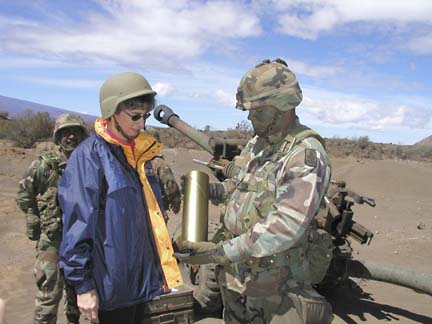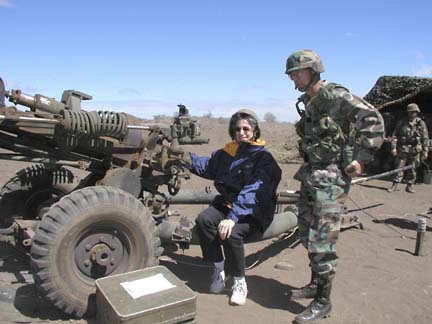
GREGG K. KAKESAKO / GKAKESAKO@STARBULLETIN.COM
Gov. Linda Lingle received a shell casing of a 105 mm howitzer round, the first one she fired as commander-in-chief of Hawaii's National Guard, from 1st Lt. David Hatcher yesterday. Lingle was visiting 29th Brigade soldiers training at the Big Island's Pohakuloa Training Area.
Citizen soldiers
train for warArmy National Guard members
accept the possibility that
they may be sent to Iraq
POHAKULOA >> For several weeks during the past three summers, Spc. Henry Farias has called these dusty and chilly plains home as he and other members of Hawaii's citizen soldiers go through battle drills, training for a mission many hope never materializes.
But with the continued demands to keep about 148,000 troops in Iraq for an undetermined period of time, the Pentagon is now considering whether to include 15 of the Army National Guard's "enhanced separate brigades" in the rotation. That decision could affect the future of Farias and the nearly 2,100 citizen soldiers who belong to the Hawaii Army National Guard's 29th Infantry Brigade.
"I really don't know what that really means to me," said Farias, a 2000 Leilehua High School graduate who was spending his third summer training here with Bravo or Primo Battery of the 29th Infantry Brigade's 1st Battalion, 487th Field Artillery.
"I think it would have to take place first before I would feel anything."
Spc. Dennis Santa Maria, a 1990 Campbell High School graduate who normally works as a mechanic at the Navy Exchange's distribution center, added: "If I'm called, yeah, I would go. That's why we're here. That's what this training is all about."
Gov. Linda Lingle noted yesterday during her first visit with the artillery unit as commander-in-chief of Hawaii's National Guard that there is a greater reliance on the National Guard and Reserves than a decade ago.
She told 18 employers, whom the National Guard had flown to this training area on a C-130 cargo plane, that citizen soldiers today no longer just train once a month. The governor, wearing a Kevlar helmet, said these soldiers have to be ready to go at a moment's notice to be part of the active military force.
Lt. Col. Keith Tamashiro, the artillery unit's commander, said he is confident that if the order ever comes, "we will be ready."
"That's why we train so hard," said Tamashiro, who as a civilian is a supervisor in the state's First-to-Work program. "It's always a challenge ... but that's my job, to ensure that the soldiers are properly trained and ready."
The Wall Street Journal reported last week that Defense Secretary Donald Rumsfeld may authorize activation of one or two "enhanced separate brigades" to go on active duty for at least a year in Iraq. These 15 National Guard units were singled out more than a decade ago to receive special training and equipment, so they could go into conflict within 90 days.
The Journal said as many as 10,000 Army National Guard soldiers could be activated as early as this winter for duty in Iraq next spring.
Brig. Gen. Vern Miyagi, commander of the Hawaii Army National Guard, said his soldiers haven't received any warning orders. The 29th Infantry Brigade is Miyagi's major combat unit and includes a battalion of more than 500 soldiers from the Army Reserve, the 100th Battalion/442nd Regiment.
GREGG K. KAKESAKO / GKAKESAKO@STARBULLETIN.COM
Gov. Lingle and Maj. Gen. Bob Lee, head of the state Department of Defense, talked with civilian employers whom the Hawaii National Guard flew to the Big Island yesterday.
However, Miyagi, who assumed command of the nearly 3,000-member citizen soldier force in April, said the brigade is ready to respond.
"If we are called, we would respond," added Miyagi. "That's what we have been training for. We have been training the same way as the active Army ... and we are ready."
Miyagi said that the 29th Infantry Brigade is considered "one of the top enhanced brigades in the Army. We're very close to the top."
The Army Guard general said he can't disclose exactly how that determination is made, but it does take into consideration the unit's strength, training and equipment readiness.
Col. Joseph Chaves, who assumed command of the 29th Brigade in May, said yesterday he believes his soldiers "are as ready as any of the enhanced brigades."
More than 362,000 soldiers are now deployed in 120 different countries, with about 132,000 in Iraq. The Army's goal now seems to be to bring home two brigades of the 3rd Division by September. Those soldiers fought in the Iraqi war and have been in the Persian Gulf for nearly a year.
The Pentagon said that of the Army's 33 brigades, 26 are committed to different missions. Sixteen of the 33 brigades are in Iraq, two are in Afghanistan and another, in Kosovo, is returning soon to Germany to be replaced by a National Guard unit.
In Hawaii, at least two units -- one brigade of the 25th Infantry Division at Schofield Barracks and the 29th Infantry Brigade assigned to the Hawaii Army National Guard -- are designated to respond to any contingency in the Pacific, especially on the Korean peninsula.
News reports last week also indicate that Army units in the Pacific may be required to rotate through Afghanistan later this year, cutting down on the number of soldiers available for duty in Iraq. The Army at Schofield Barracks said that no unit has been alerted to deploy to Afghanistan. The last big 25th Division deployment was to Bosnia last year as peacekeepers.
The Hawaii Army National Guard has already announced that at least 62 helicopter mechanics will be placed on active duty this summer, the largest number since the Vietnam War, and will be assigned to the 10th Mountain Division in Afghanistan. They are expected to be away through the Christmas holidays.

